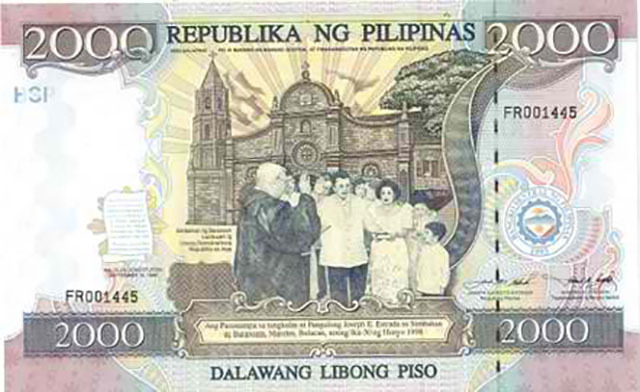
NUMISMATIC VALUE. Holders of the centennial
commemorative banknotes may choose to keep the limited edition bills for
their numismatic value. Image from BSP
This move reflects the provisions of Section 57 of Republic Act No. 7653 or the New Central Bank Act, which authorizes the BSP to replace banknotes that are more than 5 years old. (READ: FAST FACTS: What does the Bangko Sentral ng Pilipinas do?)
The BSP said the centennial commemorative banknotes will remain legal tender (mode of payment) up to July 31, 2018.
These limited edition bills can be exchanged for New Generation Currency (NGC) banknotes at full face value with the BSP from August 1, 2018 to July 31, 2019.
"Starting August 1, 2019, P100,000 and P2,000 centennial commemorative notes that have not been exchanged shall be considered demonetized," the BSP said in a statement.
But holders of the centennial commemorative banknotes may opt to keep these as collectors' items.
Currency collectors – also called numismatists – often preserve commemorative or limited release banknotes and coins for their numismatic value.
Rare banknotes
Commemorative banknotes are issued by the BSP to honor an event of historic significance to the country, the Philippines' central bank explained.
These are in limited volume, set apart from the banknotes intended for circulation and overprinted with an emblem or text descriptive of the theme or occasion being celebrated.
The BSP said the P100,000 centennial commemorative note is the biggest legal tender denomination it issued both in terms of face value and dimension, measuring 22 centimeters by 33 centimeters.

RARE. This rare banknote measures 22 centimeters by 33 centimeters, the biggest of its kind so far. Image from BSP
Only a thousand pieces of the P100,000
commemorative banknote were issued by the BSP on the occasion of the
1998 Philippine centennial year.
The P100,000 commemorative banknote
features the proclamation of Philippine independence by General Emilio
Aguinaldo on June 12, 1898 and the Sigaw ng Himagsikan (War Cry).
Also issued in 1998 was the P2,000
centennial commemorative banknote, which depicts the oath-taking of then
president Joseph Estrada and the reenactment of the declaration of
independence by former president Fidel Ramos.

LIMITED. The P2,000 centennial commemorative banknote
depicts the oath-taking of former president Joseph Estrada. Image from
BSP
"The P100,000 and P2,000 centennial notes have served their commemorative purpose. These banknotes are also part of the New Design Series which have been demonetized," the BSP said. 











0 comments:
Post a Comment